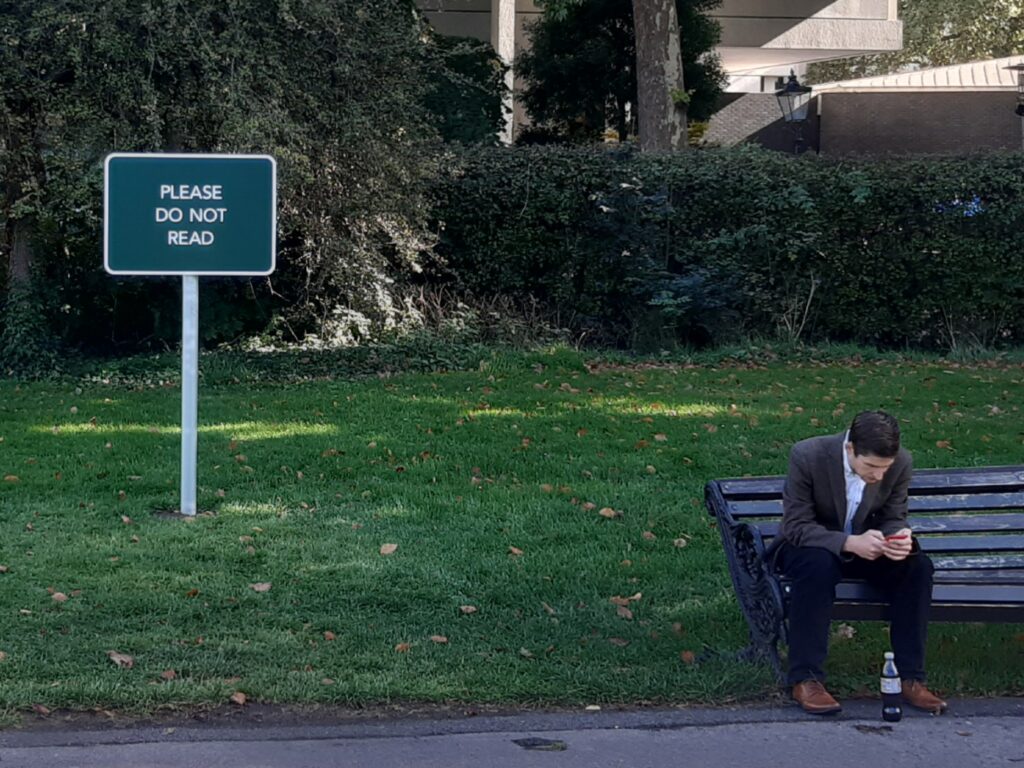Keep on the grass: The language of signs A playful exploration of instruction in public places
Free exhibition at the Building Centre, London WC1E 7BT
Keep on the grass grew out of conversations I had with colleagues about the role of signs in making people feel welcome in public places, particularly parks. I’d been working with Shared Assets and the green space and public health teams in Camden and Islington councils on their Parks for Health programme and strategy, and with UCL colleagues on the Healthy Parks Framework. This was all about ensuring parks are happy and healthy places for everyone.
Actual “Keep off the grass” and similar signs of prohibition may increasingly be a thing of the past, but they linger in our collective memory. Many people simply do not know what they can or can’t do in their local park. Far from being selfish, they want to be sure that their kids’ birthday party, their knockabout ball game or their barbecue are allowed. Is it ok to hold a yoga session in the clearing? For the art class to cluster at the viewpoint? Who do you need to ask? Do you need to fill out a form? Often as not, the answer is “yes, you can” and the process of confirming something a bit different or larger scale is not hugely onerous. But this is not widely known.
Signs aren’t everything, but they are undoubtedly more than information. They are features of urban design (or lack of design) and emblematic of a culture. Sometimes they are curiously absent; at others, they seem to have reproduced overnight. So, if the managers of our public space want the default position to be permission rather than prohibition, then signs need to signal exactly that. This means signs and information boards which are positive, unambiguous, appropriately located and not out of date. You can see some great examples of Camden Council’s signs in the exhibition.
Keep on the grass isn’t only about parks, it’s about the public realm in general and the spaces we share with each other on a day-to-day basis. We do need signs for different purposes, but “No ball games” has had its day.
Keep on the grass is a collaboration with the Built Environment Trust, based at the Building Centre in central London, and runs until 10 July (weekdays only). We plan to revisit the theme at a later date. Are there too many signs? What kind of signs work best for you? How do they make you feel? Let us know what you think and share pictures of signs you spot when you are out and about. @thebuildingcentre #LanguageOfSigns.
Read my blog The park keeper says “yes” for more about the work in Camden and Islington to foster an inclusive culture across the parks services.
David Littlefield and Mike Devereux argue that ownership of public space matters less than the quality of such places, the access we have to them, and what we are allowed to do there. Does it matter if “public ” space is privately owned? RIBAJ 23 February 2018.
Reading the signs by Abbi Flint, Rebecca Lovell and Sonia Overall reflects on the range of formal and informal signs seen along rights of way and what these might convey, in terms of both meaning and affect, to those who encounter them.
Centre for London has researched the impact on pedestrians and other pavement users of street clutter, including excessive or unnecessary signage. You can read about their work here.
Ross Atkins has designed and tested a recycled plastic support for temporary road signs which replaces the steel A-frame and sandbag, reducing both the manufacturing and usage carbon emissions and the negative impacts on street users.
Photograph above, taken at Frieze Sculpture in Regent’s Park, courtesy of Andrew Smith, Professor of Urban Experiences, University of Westminster.



